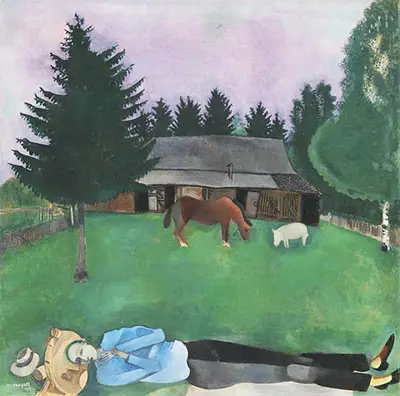It was executed in 1915. Their honeymoon, spent in Russia's countryside, seems to have brought some inspiration towards this art piece, a place he remembers as filled with fir-trees and wood solitude. It depicts the artist lounging dreamily in front of the family's country home, or dacha, during their honeymoon. At the very bottom of the illustration, he lies on the lawn with his body drastically angular. A large percentage of the image shot with a purple dusk sky and green pine forest scenery, home to a modest farmhouse and its animals.
Following Chagall's comeback to Russia after three years in Paris, the couple had reunited the preceding year in their home county of Vitebsk, where he absorbed himself in the visual experiments of the avant-garde, creating a bold colour palette and imaginative creations in reaction. He had close associations with Blaise Cendrars, Guillaume Apollinaire, and other critics and poets in Paris. Chagall's self-identification in this painting's title as a poet rather than an artist is revealing, illustrating his passion for the literary rather than the artistic realm.
The serenity of this scene is fraught with confusion and discomfort: Chagall portrays himself with a ghostly, almost lethal rictus, and the sleeping figure somewhat depicts a corpse with arms crossed over his shoulders. The figure lies in the presence of the glowing moon behind the forest. At the forefront of the forest, a peaceful pig in the sty and a horse behind the window are peacefully co-existing. Though the entire scene depicts tranquillity, the body seems peculiarly isolated.
At the outskirts of this calm scene, political and social chaos lapses as the First World War takes place on Russian soil. Perhaps the very reason for the body lying helplessly in solitude. Many of Chagall's other paintings created during this time record the influence on the Russian citizens of the war and the stunning effect that these occurrences had on Chagall upon his return. The Tate Modern in London, England, owns the Poet Reclining (Le Poète allongé). It was last on display at the Towner Gallery in Eastbourne, Sussex, in the year 2016.
